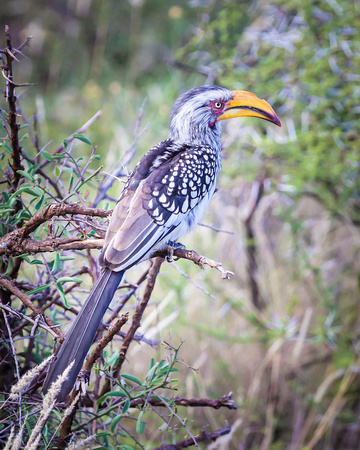Southern Yellow-billed Hornbill (Tockus leucomelas)
Southern Yellow-billed Hornbill (Tockus leucomelas)
24 inches long.
This hornbill is a common, widespread resident of the dry thorn fields and broad-leafed woodlands. They can often be seen along roads. Yellow-billed Hornbill lives in dry thorn fields, deciduous woodlands, and scrubs.
They feed mainly on the ground, where they forage for seeds, fruits, small insects, spiders, scorpions and sometimes snakes and lizards. Termites and ants are a preferred food source in the dry season. It may catch snakes, which it kills beating them strongly on hard surface. It swallows the whole prey, and rejects indigestible parts.
Females lay three to four white eggs in their nest cavities and incubate them for about 25 days. Juveniles take about 45 days to mature.
Nests in a hole in tree. This cavity is lined with dry grasses and leaves. The female lays 3 to 4 white eggs in closed cavity. Incubation lasts about 25 days, by female alone, fed by male. Chicks are fed by female in the hole during three weeks with regurgitated food. Then, female leaves the nest, and young reseal the hole themselves. They stay 40 to 45 days more in the nest, fed by both parents. When they fledge, they perch a few days in the tree on the nest site, moving their wings before taking off. They reach their sexual maturity at one year. This species produces only one brood per year.
Photographed in Madikwe Game Reserve, North West, South Africa.


